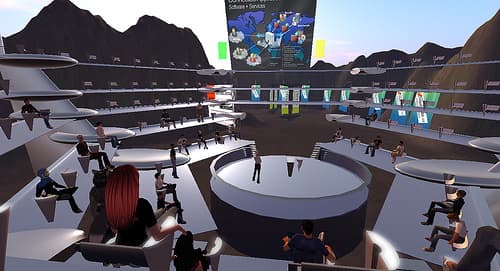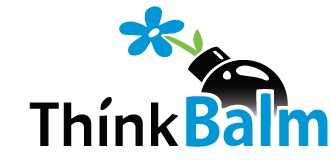- in Blog Articles by Erica Driver
At Microsoft, cost of virtual events about 1/3 the cost of traditional events
In late June I spoke with Microsoft Developer Network (MSDN) evangelist Zain Naboulsi about how Microsoft is using virtual worlds to strengthen the company’s relationships with customers via its technical communities. Microsoft has about 700 members in its MSDN developers group and about 150 members in its TechNet group. MSDN is for software developers while TechNet is more for system administrators, networking engineers, database administrators, and other technical folks. IT professionals use these communities to get answers to questions, share their expertise, and simply hang out with each other (virtually, for the most part, via Web-based forums and discussion groups).

Microsoft product launch event in Second Life. Source: Flickr user G2 Virtual Worlds-Microsoft Launch 2008
Naboulsi and his team initially had the goal of holding virtual events and user group meetings in an immersive environment.The team experimented with Blizzard Entertainment’s World of Warcraft massively multiplayer online role-playing game (MMORPG) for a while before co-opting and then adopting a pre-existing Microsoft island in Linden Lab’s Second Life virtual world. Lo and behold – IT professionals began to show up for in-world user group meetings and small events. The tipping point took place in April of 2008 when Microsoft launched three new product releases: SQL Server 2008, Windows Server 2008, and Visual Studio 2008. The company launched these products not only at the usual press conference and subsequent customer events all across the US but at a three-track conference in Second Life. (Tish Shute talked a bit about this in her Ugotrade blog post “Microsoft Dev Community In OpenSim/realXtend.”) The “in-world” product launch event was very successful as measured by:
- Lots of warm bodies – well, avatars. About 150 people (avatars) registered for the launch event in Second Life and Microsoft wound up with 220 actual participants – nearly a 150% attendance rate. This doesn’t include the estimated more than 270 avatars that just dropped into the event for a small portion of it. While I don’t know how many people attended the traditional launch events, two hundred plus participants is more than tend to show up at comparable traditional physical-world events. I’ve done dozens of presentations at vendor events like these – Microsoft’s and others — and I’d say that on average the audience size tends to be in the 30-50 range. A really top-notch sales district might come in at a few hundred attendees but it’s a rarity.
- Most attendees devoting their entire day to the event. About 90% of attendees stayed for the entire day – a stickiness ratio pretty much unheard of at traditional vendor sales and marketing events. At traditional events, attendees tend to start dribbling out after the first couple of presentations and trickle out even faster after lunch. Technology vendors (not just Microsoft) try to keep people in the room for as long as possible with high-quality presentations and tasty food and by offering non-trivial raffle prizes at the end (say, a PDA or digital music player or a software package worth a few hundred bucks). Naboulsi’s explanation for the low dropoff rate: people came and stayed because they were learning.
- Attendees reporting quality hands-on learning at the in-world event. Participants could go through examples alongside the presenter, if they had a second PC or ALT+TABbed back and forth between the event going on in SL and a copy of the Microsoft software on their machine. They could practice, say, virtualizing a Windows server. Contrast this with a traditional event, where audience members may passively watch a presenter do a demo — a far cry from being able to get their hands on the software themselves and have a go at it.
- The company’s costs being a lot lower than for traditional events. This in-world launch event cost Microsoft about $4,000. The company didn’t have to rent a meeting room, cater in food, or pay for airfare and hotel room for speakers coming in from out of town. The company didn’t have to buy raffle prizes and other promotional items (how many pens, pads of paper, and thumb drives do you have from attending vendor events)? And now that Microsoft has built many of the assets it needs for in-world events (e.g., meeting spaces, presentation screens, etc.) the company is able to run in-world events at about 1/3 of the cost of doing comparable physical events – and as you scale up the number of attendees at in-world events the cost per attendee drops down even lower.
Lessons learned: how to get started
MSDN evangelist Zain Naboulsi has had enough success with the communities he has managed to build up and the events he has run in-world that he is now encouraging Microsoft to use Immersive Internet technologies more broadly, both internally and externally. He acknowledges that getting people to buy into the Immersive Internet vision can be a tough sell. He found a few things that really work:
- Start with pictures. Pictures truly are worth a thousand words when what you’re trying to describe is hard for most people to imagine. Naboulsi used to lay down a thick layer of peer pressure along the lines of “Getting into virtual worlds is a good thing. You need to do it — everyone is doing it.” But he found that talking about it isn’t enough. Instead he accompanies stories about what he’s been able to accomplish with snapshots from the high-value events he has facilitated in-world.
- Once people are comfortable with pictures, take them in-world. It isn’t until the second meeting that Naboulsi takes his colleagues into a virtual world to show them around. Why? Some of them don’t have adequate graphics cards or processors on their machines to provide a quality experience. And the learning curve (e.g., creating an account, selecting an avatar, moving the avatar around, navigating through menus) is a huge barrier for the uninitiated. Naboulsi and his colleagues will spend up to two hours with key people they want to help feel more comfortable with the idea of virtual worlds, educating them and teaching them some basic skills.
- Demonstrate the business value. At ThinkBalm we strongly encourage Immersive Internet ROI discussions to focus on specific business process improvements. Naboulsi and his team have done just this. You see the numbers above, focused on drawing larger crowds to Microsoft events at a lower cost than before and increasing the amount of time attendees will spend at the events. The math must work or Microsoft wouldn’t keep doing sales and marketing events — quality face time with customers really does result in new and bigger software license deals.
- Nurture the natural leaders who will rise to the top. In Naboulsi’s words, “Evangelism means fostering communities, not running them.” This means allowing natural community leaders to rise up out of the crowd. In the case of MSDN, one of the community leaders is Kyle Gomboy. Gomboy stumbled across the Microsoft island in Second Life and met Naboulsi there, alongside others like published author on Microsoft ASP.net Christine Hart. Over time, Gomboy took on responsibility for helping to transform the Microsoft island to a social meeting place where technical folks can come and share their creations and have a good time with like-minded people – importantly, at little or no cost to Microsoft. (For more thoughts on leadership in an Immersive Internet world see our June 3, 2008 article, MMORPG guild leaders: Gurus in the midst.)
We didn’t get into it here in this article but the community, led by Kyle Gomboy, is hard at working developing a more heavy-duty virtual environment solution that incorporates Microsoft technology and runs on OpenSim. It will be more closely integrated with Microsoft’s office productivity and communication and collaboration tools than what is currently available with Second Life. Stay tuned for more info!
